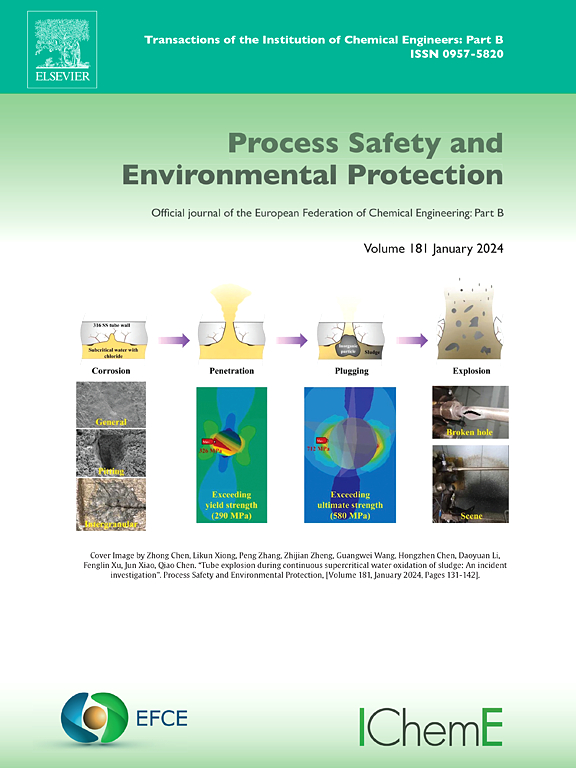20 L室中含不同氢组分的沼气-氢气-空气混合物爆炸危险性的定量分析
IF 6.9
2区 环境科学与生态学
Q1 ENGINEERING, CHEMICAL
引用次数: 0
摘要
采用20 L球形爆炸室,通过测量最大爆炸压力、最大升压率、爆燃指数和层流燃烧速度等爆炸参数,研究了沼气-氢-空气混合物的爆炸危险性和严重程度。准确的爆燃指数是用平滑的压力-时间曲线得到的最大压力上升率来计算的。随着沼气-氢气-空气混合物中氢气含量的增加,各参数的取值单调增加:最大爆炸压力增加了1.33倍,最大升压率和爆燃指数增加了2.54倍,层流燃烧速度增加了1.7倍。加氢缩短了爆燃时间,加速了压力的积累。少量氢气的加入会导致接近纯甲烷的爆炸危险。综上所述,在沼气-空气混合物中添加氢气会显著增加爆炸风险和严重程度。本文章由计算机程序翻译,如有差异,请以英文原文为准。
Quantification of the explosion risk of biogas-hydrogen-air mixtures with various hydrogen fractions in a 20 L chamber
The explosion risk and severity of biogas-hydrogen-air mixtures are investigated by measuring the explosion parameters—namely, the maximum explosion pressure, maximum pressure rise rate, deflagration index, and laminar burning velocity—using a 20 L spherical explosion chamber. Accurate deflagration indices are calculated using the maximum pressure rise rate derived from a smoothed pressure–time curve. The values of all parameters increase monotonously with increasing hydrogen fraction in biogas-hydrogen-air mixtures: the maximum explosion pressure increases by up to 1.33 times, the maximum pressure rise rate and deflagration index increase by up to 2.54 times, and the laminar burning velocity increases by up to 1.7 times. Hydrogen addition shortens the deflagration duration and accelerates pressure build-up. The addition of a small amount of hydrogen leads to an explosion risk close to that of pure methane. In summary, the addition of hydrogen into biogas-air mixtures significantly increases the explosion risk and severity.
求助全文
通过发布文献求助,成功后即可免费获取论文全文。
去求助
来源期刊

Process Safety and Environmental Protection
环境科学-工程:化工
CiteScore
11.40
自引率
15.40%
发文量
929
审稿时长
8.0 months
期刊介绍:
The Process Safety and Environmental Protection (PSEP) journal is a leading international publication that focuses on the publication of high-quality, original research papers in the field of engineering, specifically those related to the safety of industrial processes and environmental protection. The journal encourages submissions that present new developments in safety and environmental aspects, particularly those that show how research findings can be applied in process engineering design and practice.
PSEP is particularly interested in research that brings fresh perspectives to established engineering principles, identifies unsolved problems, or suggests directions for future research. The journal also values contributions that push the boundaries of traditional engineering and welcomes multidisciplinary papers.
PSEP's articles are abstracted and indexed by a range of databases and services, which helps to ensure that the journal's research is accessible and recognized in the academic and professional communities. These databases include ANTE, Chemical Abstracts, Chemical Hazards in Industry, Current Contents, Elsevier Engineering Information database, Pascal Francis, Web of Science, Scopus, Engineering Information Database EnCompass LIT (Elsevier), and INSPEC. This wide coverage facilitates the dissemination of the journal's content to a global audience interested in process safety and environmental engineering.
 求助内容:
求助内容: 应助结果提醒方式:
应助结果提醒方式:


